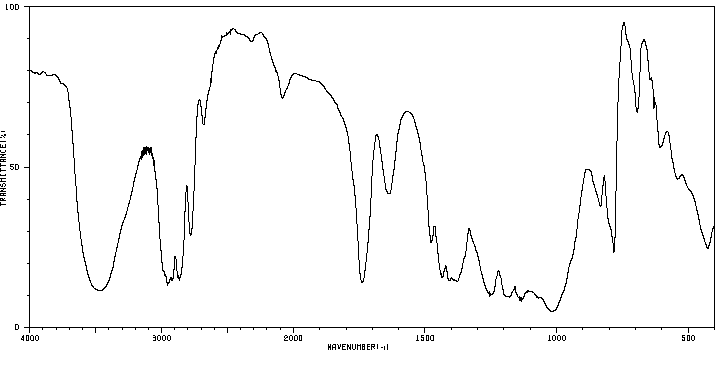[(乙烯基氧基)甲氧基]乙烯 | 111-38-6
中文名称
[(乙烯基氧基)甲氧基]乙烯
中文别名
乙烯,1,1-亚甲基二(氧代)二-
英文名称
bis(vinyloxy)methane
英文别名
divinyl formal;bis-vinyloxy-methane;formaldehyde divinylacetal;Formaldehyd-divinylacetal;Bis-vinyloxy-methan;Methylen-glykol-divinylether;Ethenoxymethoxyethene
CAS
111-38-6
化学式
C5H8O2
mdl
——
分子量
100.117
InChiKey
DFFZYNIDEOOVAU-UHFFFAOYSA-N
BEILSTEIN
——
EINECS
——
-
物化性质
-
计算性质
-
ADMET
-
安全信息
-
SDS
-
制备方法与用途
-
上下游信息
-
文献信息
-
表征谱图
-
同类化合物
-
相关功能分类
-
相关结构分类
计算性质
-
辛醇/水分配系数(LogP):1.5
-
重原子数:7
-
可旋转键数:4
-
环数:0.0
-
sp3杂化的碳原子比例:0.2
-
拓扑面积:18.5
-
氢给体数:0
-
氢受体数:2
安全信息
-
海关编码:2909199090
SDS
反应信息
-
作为反应物:参考文献:名称:Lesiak,T.; Maciejewski,L., Journal fur praktische Chemie (Leipzig 1954), 1978, vol. 320, p. 239 - 245摘要:DOI:
-
作为产物:描述:参考文献:名称:DE895452摘要:公开号:
文献信息
-
Insertion Polymerization of Divinyl Formal作者:Zhongbao Jian、Stefan MeckingDOI:10.1021/acs.macromol.6b00983日期:2016.6.28six-membered (cis-/trans-1,3-dioxane) cyclic acetal units in the main chain, and also in the initiating ends of this functionalized polyethylene. Comprehensive NMR analysis of the microstructure of these copolymers revealed that under pressure reactor conditions consecutive 2,1–1,2-insertion of divinyl formal into a Pd–H bond is preferred, but consecutive 1,2–1,2-insertion of divinyl formal into more bulky Pd–alkyls乙烯和二乙烯基缩甲醛的共聚由[κ 2 - P,O-(2-MeOC 6 H ^ 4)2 PC 6 H ^ 4 SO 3 } PDME(DMSO)](1)通过配位-插入机构,得到高度线性聚乙烯具有高(12.5mol%)二乙烯基甲醛的掺入。这大大超过了迄今为止插入聚合中相对较低的掺入量(6.9mol%)和与乙烯基醚单体的活性。所得的乙烯-二乙烯基正式共聚物(> 98%)仅包含五元(反式-1,3-二氧戊环)和六元(顺-/反式)在主链中以及在该官能化聚乙烯的起始端具有-1,3-二恶烷环缩醛单元。对这些共聚物的微观结构进行的全面NMR分析表明,在压力反应器条件下,连续2,1–1,2-插入二乙烯基甲醛成Pd-H键是优选的,但是连续1,2-1,2-插入二乙烯基正式使用更大体积的Pd-烷基(增长的聚合物链)。此外,二乙烯基缩甲醛的均聚得到的非交联聚(二乙烯基缩甲醛)与度DP的聚合Ñ ≈26。
-
van Melick,J.E.W. et al., Recueil des Travaux Chimiques des Pays-Bas, 1973, vol. 92, p. 1027 - 1039作者:van Melick,J.E.W. et al.DOI:——日期:——
-
Shostakovskii,M.F. et al., Journal of general chemistry of the USSR, 1971, vol. 41, p. 610 - 613作者:Shostakovskii,M.F. et al.DOI:——日期:——
-
LESIAK T.; MACIEJEWSKI L., J. PRAKT. CHEM., 1978, 320, NO 2, 239-245作者:LESIAK T.、 MACIEJEWSKI L.DOI:——日期:——
表征谱图
-
氢谱1HNMR
-
质谱MS
-
碳谱13CNMR
-
红外IR
-
拉曼Raman
-
峰位数据
-
峰位匹配
-
表征信息
同类化合物
(反式)-4-壬烯醛
(s)-2,3-二羟基丙酸甲酯
([1-(甲氧基甲基)-1H-1,2,4-三唑-5-基](苯基)甲酮)
(Z)-4-辛烯醛
(S)-氨基甲酸酯β-D-O-葡糖醛酸
(S)-3-(((2,2-二氟-1-羟基-7-(甲基磺酰基)-2,3-二氢-1H-茚满-4-基)氧基)-5-氟苄腈
(R)-氨基甲酸酯β-D-O-葡糖醛酸
(5,5-二甲基-2-(哌啶-2-基)环己烷-1,3-二酮)
(2,5-二氟苯基)-4-哌啶基-甲酮
龙胆苦苷
龙胆二糖甲乙酮氰醇(P)
龙胆二糖丙酮氰醇(P)
龙胆三糖
龙涎酮
齐罗硅酮
齐留通beta-D-葡糖苷酸
鼠李糖
黑芥子苷单钾盐
黑海棉酸钠盐
黑木金合欢素
黑曲霉三糖
黑介子苷
黄尿酸8-O-葡糖苷
麻西那霉素II
麦迪霉素
麦芽糖脎
麦芽糖基海藻糖
麦芽糖1-磷酸酯
麦芽糖
麦芽四糖醇
麦芽四糖
麦芽十糖
麦芽六糖
麦芽五糖水合物
麦芽五糖
麦芽五糖
麦芽五糖
麦芽三糖醇
麦芽三糖
麦芽三糖
麦芽三塘水合
麦芽七糖水合物
麦芽七糖
麦法朵
麦可酚酸-酰基-Β-D-葡糖苷酸
麦利查咪
麝香酮
鹤草酚
鸢尾酚酮 3-C-beta-D-吡喃葡萄糖苷
鸡矢藤苷







